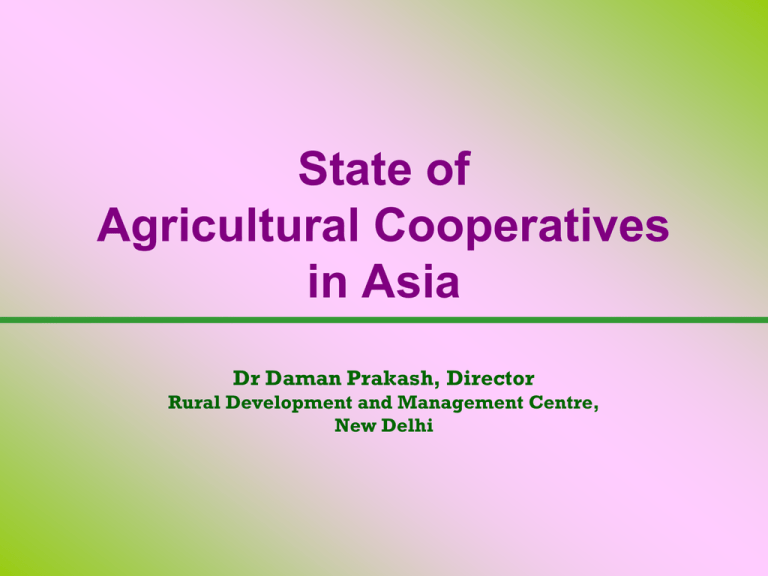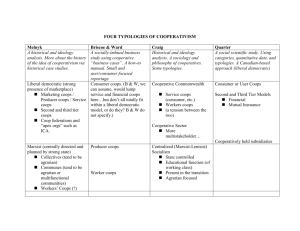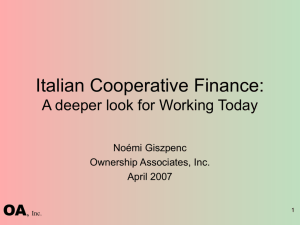Status of Agricultural Cooperatives in Asia Dr Daman Prakash
advertisement

State of Agricultural Cooperatives in Asia Dr Daman Prakash, Director Rural Development and Management Centre, New Delhi Cooperative Movement is International Encompasses all Types of Economies Covers all Forms of Cooperatives Based on Principles of Cooperation COOPERATIVE PRINCIPLES ARE PROPAGATED BY INTERNATIONAL COOPERATIVE ALLIANCE [ICA] ICA WORLD NETWORK OF COOPERATIVES Established 1895 in London by International Cooperative Congress 800 Million Individual Members, 200 Member-Organisations, 90 Countries. Head Office located in Geneva. Switzerland, and Regional Offices ICA REGIONAL OFFICE FOR ASIA-PACIFIC IS LOCATED IN NEW DELHI-INDIA India is an Important Member of ICA with 21 National-level Affiliates COOPERATIVE PRINCIPLES safeguard independence, autonomy and character of cooperative institutions all over the world PRINCIPLES OF COOPERATION <Definition> “A cooperative is an autonomous association of persons united voluntarily to meet their common economic, social and cultural needs and aspiration through a jointly-owned and democratically-controlled enterprise” PRINCIPLES OF COOPERATION Voluntary and Open Membership Democratic Member Control Member Economic Participation Autonomy and Independence Education, Training & Information Cooperation among Cooperatives Concern for the Community COOPERATIVE PRINCIPLES ARE BASED ON: [A] Basic Cooperative Values Self-Help, Self-Responsibility, Democracy, Equality, Equity, and Solidarity [B] Ethical Values Honesty, Openness, Social Responsibility, and Caring for Others WORLD GROUPING OF COOPERATIVES Consumer Coops = 36%. Members 22% Agricultural Coops = 42%. Members 61% Other Forms = 22%. Members 17% IN ASIA-PACIFIC REGION LARGEST NUMBER OF AGRICULTURAL COOPS AND MEMBERS AGRICULTURE IS THE MAINSTAY OF ASIAN ECONOMIES Review of Status of Agricultural Cooperatives in Asian Region 15 COUNTRIES Bangladesh, China, India, Indonesia, Japan, Laos, Malaysia, Mongolia, Myanmar, Nepal, Pakistan, The Philippines, Sri Lanka, Thailand, Vietnam BANGLADESH P.152 million. 80% rural population. 40% share of agriculture in GDP. Coops introduced in 1904. 57,000 coops [28,000 agri]. Two streams of cooperatives. Major Sectors are: Rice, Fisheries, Milk, Livestock and Horticulture CHINA P.1.3 b. 80% farmers. Organised 1918. Commune/Collective System. Coop Law 1935. 35,200 agri coops. 80,000 business units with membership of 180 million. INDIA P. 1.1b. Estb in 1904. Now 550,000 coops with 300 million members. 65% agricoops. All villages covered. Major Sectors: Fertiliser, Sugar, Milk, Oilseed. No. 1 milk producer. IFFCO world’s largest. Largest agricredit & HRD structure. 22 national federations. INDONESIA P.230 million. 1948 National Constitution recognises Cooperatives. 9,200 KUDs, 13 million members. Verticle structure of federations [promotional+business]. Major sectors: Rice, Horticulture, Plantations, Forests, Spices. HRD structure exists. JAPAN P.130m.Coops. Reorganised after World War-II. Agricoops strongest and High-Tech. 750 JAs, 10 million farmer-members. Full Services: Marketing, Supply, Credit & Guidance. ‘Cradle to Grave’ Services. JA-Zenchu provides Education, Farm Guidance and Audit. LAOS PDR P.6m.No formal agricoops at present. Earlier 16,000 coops. Reorganisation taking place after internal conflicts. Presently farmers’ groups. Major sectors: Rice, Forestry, Horticulture MALAYSIA P. 28 million. Introduced in 1922. Reorganised. Coop Act 1993. 1973 Farmers’ Organisations Act. 598 agricoops, 645,000 members. Major Sectors: Rice, Forestry, Spices, Plantations [Oilpalm, Rubber, Coconut] MONGOLIA P.3 million. 40% are nomads handling livestock. First established 1921, later reorgannised 1930. 1998 Coop Law promoted livestock & agricoops. Wool/Pashmina. Presently – 900 agricoops. MYANMAR P.52 million. 66% people engaged in agriculture. Coop Law of 1970. 6,700 coops, 500 coop syndicates. Main sectors: Rice, Forestry, Fisheries, Pulses, Sugar, Rubber, Tobacco and Horticulture. NEPAL P.29 million. Agriculture share 40% in GDP. Employs 81% people. First Coop Law 1959. Reorganised-Law of 1992. At present 2,400 agricoops. Main Sectors: Rice, Forestry, Horticulture, Dairy. PAKISTAN P.160m. First established 1904. In 2000 there were 66,178 coops with 3.5 million members. Agricoops 46,615. Main Sectors: Wheat, Rice, Fruits & Vegetables. THE PHILIPPINES P.85 million. Law of 1990. 42,000 registered coops with 6 million members. Main Sectors: Rice, Sugar, Forestry, Fisheries, Tobacco, Horticulture SRI LANKA P.22 million. Estd 1904. 955 MPCS were amalgamated in 1972 into 372 MPCS. Main Sectors: Rice, Plantations [Tea and Coffee], Rubber, Spices, Maize, Horticulture. THAILAND P.66 million. Introduced 1915. Groups: Agricoops, Land Settlement, Fisheries, Consumer, Thrift & Credit, and Service Cooperatives. 5,340 Coops with 8.3 million members. VIETNAM P.85 million. 78% workforce depends on agriculture. 50% share of GNP. 16,243 coop enterprises. Transformation under way from commune/collectives. Main sectors: Rice, Forestry, Fisheries, Horticulture, Sugar. World’s largest table rice producer. CONCLUSIONS Agriculture plays important role; Food production and employment; Federal structure exists; Mainly Government-sponsored; Crucial period 1900-1940; Gradual withdrawal of Govt from Coops; Opportunities & Problems for Coops; Low trade network among cooperatives; Processing activity is Low. Thank You Very Much for your kind attention State of Agricultural Cooperatives in Asia Dr Daman Prakash. RDMC-New Delhi











